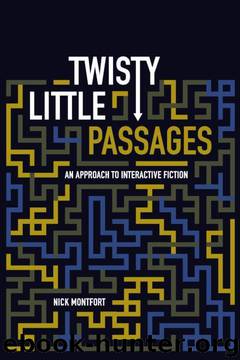Twisty Little Passages: An Approach to Interactive Fiction by Nick Montfort

Author:Nick Montfort
Language: eng
Format: mobi
Published: 2011-05-11T10:01:00+00:00
Gathering treasure is an important part of Zork II, but assembling the booty in a trophy case is not the ultimate goal. In order to win, the interactor must have the player character supply these treasures to a powerful demon. This demon (like the robot) will do the adventurer a critical service-after he is propitiated. From the standpoint of the adventurer, Zork II adds a new and innovative motivation to the usual drive to plunder: Satanism. Such demonic elements were also found in Zork: The Malifestro Quest, a spin-off book for children that used a format similar to those of Choose Your Own Adventure books. A Cape Cod newspaper, The Register, reported a denunciation of this book in its 16 May 1995 issue. Jan Leary, the mother of one of this book's readers, called for the book to be removed from the school library and school book fairs. "Such reading promotes demonic worship," Leary said, "and glorifies violence for school children" (qtd. in Infocom, Inc. 1985).The more detailed and interactive Satanic experience of Zork II, in which the player character must summon a demon, enlist him to service, and (essentially) instruct him to murder someone, would no doubt have raised even more severe concerns-if it had even been noticed by parents. Text adventures were inaccessible, however, to those not adept at puzzle solving and not fluent in the dialect of English their parsers understood. This marginalized the form, but it also may have helped it elude strict parental control. By being esoteric, interactive fiction was less likely to be noticed by those who would suppress free expression. It was still noticed by some, though, who seized on any mention of magic (e.g., in the packaging or in advertisements) as proof that, as Steven Meretzky (2002) said, "Infocom was actually the Great Satan."
Zork II contains the Oddly-Angled Room, a particularly confounding pseudomaze. In order to get through it, the player character must move through the rooms in a diamond pattern, as if playing baseball. This puzzle has been rightly decried as involving a confusing intrusion of contemporary culture into a subterranean fantasy world. Similar complaints are not often made about the anachronistic placement of contemporary machinery, engineering, electrical devices (e.g., the brass lantern) and even a robot in different parts of Zork I-III. That sort of juxtaposition appealed to most of the interactors who played the games in the trilogy early on-anyone who used a computer in the early 1980s was necessarily fascinated with technology and was often amused to see it placed in a fantasy context. Since recent technologies are distributed throughout the IF world and cleverly incorporated into puzzles, they help to create a distinctive atmosphere. The baseball pseudomaze is different in that it relies on rules that are not a part of physics, engineering, or logic. The puzzle also points out how Infocom's works, although often set in other countries or in alternate or future worlds, were created in the context of the United States, with American assumptions.
Download
This site does not store any files on its server. We only index and link to content provided by other sites. Please contact the content providers to delete copyright contents if any and email us, we'll remove relevant links or contents immediately.
The Mikado Method by Ola Ellnestam Daniel Brolund(12292)
Hello! Python by Anthony Briggs(12183)
Dependency Injection in .NET by Mark Seemann(11336)
The Well-Grounded Java Developer by Benjamin J. Evans Martijn Verburg(9811)
Secrets of the JavaScript Ninja by John Resig Bear Bibeault(9045)
Sass and Compass in Action by Wynn Netherland Nathan Weizenbaum Chris Eppstein Brandon Mathis(9032)
Svelte with Test-Driven Development by Daniel Irvine(8094)
Test-Driven Development with PHP 8 by Rainier Sarabia(7850)
Kotlin in Action by Dmitry Jemerov(7740)
Layered Design for Ruby on Rails Applications by Dementyev Vladimir;(7658)
Secrets of the JavaScript Ninja by John Resig & Bear Bibeault(7579)
Web Development with Django by Ben Shaw Saurabh Badhwar(7161)
React Application Architecture for Production by Alan Alickovic(6853)
Jquery UI in Action : Master the concepts Of Jquery UI: A Step By Step Approach by ANMOL GOYAL(6564)
Software Architecture for Web Developers by Mihaela Roxana Ghidersa(4954)
Audition by Ryu Murakami(4850)
Accelerating Server-Side Development with Fastify by Manuel Spigolon Maksim Sinik & Matteo Collina(4807)
Solidity Programming Essentials by Ritesh Modi(4532)
Hands-On Full-Stack Web Development with GraphQL and React by Sebastian Grebe(4413)
